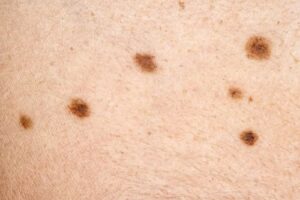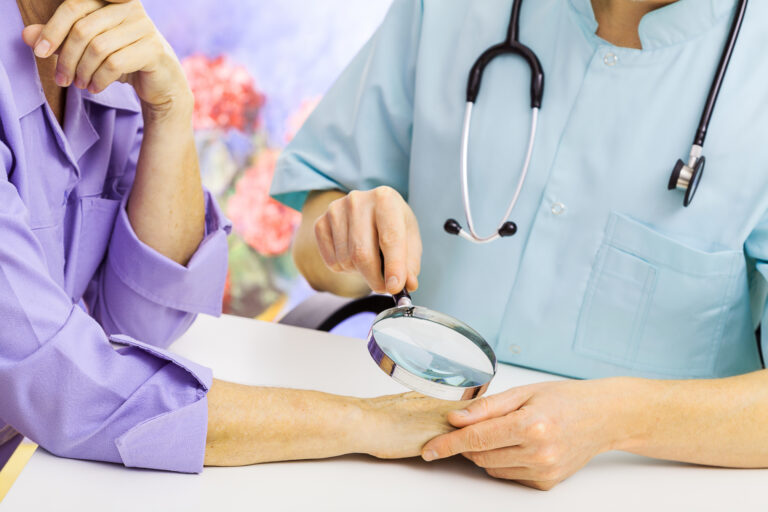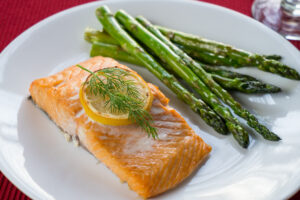What Is Skin Cancer?
The skin is the body’s largest organ. Skin has several layers, but the two main layers are the epidermis (upper or outer layer) and the dermis (lower or inner layer). Skin cancer begins in the epidermis, which is made up of three kinds of cells—
- Squamous cells: Thin, flat cells that form the top layer of the epidermis.
- Basal cells: Round cells under the squamous cells.
- Melanocytes: Cells that make melanin and are found in the lower part of the epidermis. Melanin is the pigment that gives skin its color. When skin is exposed to the sun, melanocytes make more pigment and cause the skin to darken.
Basal and squamous cell carcinomas are the two most common types of skin cancer. They begin in the basal and squamous layers of the skin, respectively. Both can usually be cured, but they can be disfiguring and expensive to treat.
Melanoma, the third most common type of skin cancer, begins in the melanocytes. Of all types of skin cancer, melanoma causes the most deaths because of its tendency to spread to other parts of the body, including vital organs.
Most cases of skin cancer are caused by overexposure to ultraviolet (UV) rays from the sun, tanning beds, or sunlamps. UV rays can damage skin cells. In the short term, this damage can cause a sunburn. Over time, UV damage adds up, leading to changes in skin texture, premature skin aging, and sometimes skin cancer. UV rays also have been linked to eye conditions such as cataracts.
What Are the Risk Factors?
Anyone can get skin cancer, but people with certain characteristics are at greater risk—
- A lighter natural skin color.
- Skin that burns, freckles, reddens easily, or becomes painful in the sun.
- Blue or green eyes.
- Blond or red hair.
- Certain types and a large number of moles.
- A family history of skin cancer.
- A personal history of skin cancer.
- Older age.
Exposure to UV Rays
Regardless of whether you have any of the risk factors listed above, reducing your exposure to ultraviolet (UV) rays can help keep your skin healthy and lower your chances of getting skin cancer in the future. Most people get at least some UV exposure from the sun when they spend time outdoors. Making sun protection an everyday habit will help you to enjoy the outdoors safely, avoid getting a sunburn, and lower your skin cancer risk.

What Are the Symptoms of Skin Cancer?
A change in your skin is the most common sign of skin cancer. This could be a new growth, a sore that doesn’t heal, or a change in a mole. Not all skin cancers look the same.
For melanoma specifically, a simple way to remember the warning signs is to remember the A-B-C-D-Es of melanoma—
- Asymmetrical: Does the mole or spot have an irregular shape with two parts that look very different?
- Border: Is the border irregular or jagged?
- Color: Is the color uneven?
- Diameter: Is the mole or spot larger than the size of a pea?
- Evolving: Has the mole or spot changed during the past few weeks or months?
Talk to your doctor if you notice changes in your skin such as a new growth, a sore that doesn’t heal, a change in an old growth, or any of the A-B-C-D-Es of melanoma.
What Can I Do to Reduce My Risk of Skin Cancer?
Most skin cancers are caused by too much exposure to ultraviolet (UV) rays. UV rays come from the sun, tanning beds, and sunlamps. UV rays can damage skin cells.
To lower your risk of getting skin cancer, you can protect your skin from UV rays from the sun, and avoid artificial sources of UV exposure like tanning beds and sunlamps.
Practice Sun Safety
Protection from UV rays is important all year, not just during the summer. UV rays can reach you on cloudy and cool days, and they reflect off of surfaces like water, cement, sand, and snow. In the continental United States, UV rays are strongest from 10 a.m. to 4 p.m. daylight saving time (9 a.m. to 3 p.m. standard time).
The UV Index forecasts the strength of UV rays each day. If the UV index is 3 or higher in your area, protect your skin from too much exposure to the sun. CDC recommends several ways to protect your skin when the UV index is 3 or higher—
- Stay in the shade.
- Wear clothing that covers your arms and legs.
- Wear a hat with a wide brim to shade your face, head, ears, and neck.
- Wear sunglasses that wrap around and block both UVA and UVB rays.
- Use a broad-spectrum sunscreen with a sun protection factor (SPF) of 15 or higher.
A tan does not indicate good health. When UV rays reach the skin’s inner layer, the skin makes more melanin. Melanin is the pigment that gives skin its color. It moves toward the outer layers of the skin and becomes visible as a tan. Any change in skin color after UV exposure (whether it is a tan or a burn) is a sign of injury, not health.
What Screening Tests Are There?
The U.S. Preventive Services Task Force (USPSTF) has concluded there is not enough evidence to recommend for or against routine screening (total body examination by a doctor) to find skin cancers early. This recommendation is for people who do not have a history of skin cancer and who do not have any suspicious moles or other spots.
Checking your skin for moles regularly will help you find any suspicious changes. Be sure to check less visible areas of your skin like the soles of your feet. Tell your doctor about any unusual moles or changes in your skin. Also talk to your doctor if you are at increased risk of skin cancer.
For more information, visit the National Cancer Institute’s Skin Cancer Screening at www.cancer.gov/types/skin/patient/skin-screening-pdq
Are There Benefits to Spending Time Outdoors?
Spending time outdoors can improve overall health and wellness. The outdoors offers many opportunities to be physically active. Time outdoors may also promote mental health and stress reduction. While enjoying the benefits of being outdoors, people can decrease skin cancer risk from too much UV exposure by using sun protection. Protect yourself by staying in the shade, wearing protective clothing, and applying and re-applying a broad spectrum sunscreen with a sun protection factor (SPF) of 15 or higher. Communities can help by ensuring shade is available in public parks. Schools and businesses may consider adding shade to school grounds and places were people gather outside.
Ultraviolet (UV) rays from the sun can stimulate production of vitamin D in the skin. Having little or no sun exposure may put a person at risk for low levels of vitamin D, but too much UV exposure from the sun or artificial sources can increase risk of skin cancers and eye disease. The amount of vitamin D a person’s skin makes when they are in the sun depends on many factors, including skin tone, geographic location, weather conditions, time of year, and time of day.
You can also get vitamin D through your diet. Food sources of vitamin D include some types of fish; foods with added vitamin D, such as some cereals; juices; dairy products; and egg yolks.
The skin can produce only a limited amount of vitamin D at one time. Once the body has reached this limit, spending more time in the sun will not continue to increase vitamin D levels. However, continued time in the sun will increase your skin cancer risk. There is no known level of UV exposure that would increase vitamin D levels without also increasing skin cancer risk. Vitamin D can be obtained safely through food and dietary supplements without the risks associated with overexposure to UV.
Source: CDC, https://www.cdc.gov/cancer/skin/basic_info/what-is-skin-cancer.htm
Easy Broiled Salmon Fillets
A 3.5-ounce salmon fillet contains up to 125% of the recommended daily intake of vitamin D. Wild-caught contains more nutrients than farm-raised.
Ingredients (4 Servings)
- 4 4-ounce salmon fillets
- 1 tablespoon cooking oil
- 1 tablespoon soy sauce
- 1 tablespoon Worcestershire sauce
- 1/8 tablespoon garlic powder
- Dash of Tabasco (optional)
- 4 thinly sliced tomatoes, 10 capers and rosemary sprigs for garnish (optional)
Directions
- Place salmon fillets in a shallow baking dish that has been sprayed with oil.
- Combine soy sauce, Worcestershire sauce, garlic powder and canola oil, and pour mixture over the fillets.
- Bake the salmon at 450 degrees F for 12 minutes or until it flakes easily with a fork.
- Or, sear the salmon in a pan on medium-high heat for two to three minutes per side or until it flakes easily with a fork.
Nutritional information
- 150 calories
- 21 g protein
- 14 g fat
- 1 g carbohydrate
- 305 mg sodium
- 800 mg omega 3 fatty acid
https://www.ucihealth.org/blog/2015/10/broiled-salmon



